LASIK
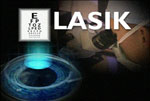 One of the most popular ways to correct vision is with a procedure called LASIK (laser in-situ keratomileusis), which uses a laser to change the curvature of the cornea (outer window of the eye). LASIK has quickly become the procedure of choice for most patients because they recover quickly and have fewer side effects and complications than with other methods of vision correction. In fact, most LASIK patients notice a significant improvement in their vision soon after surgery. LASIK removes tissue within the cornea to treat low to high levels of nearsightedness, farsightedness and astigmatism.
One of the most popular ways to correct vision is with a procedure called LASIK (laser in-situ keratomileusis), which uses a laser to change the curvature of the cornea (outer window of the eye). LASIK has quickly become the procedure of choice for most patients because they recover quickly and have fewer side effects and complications than with other methods of vision correction. In fact, most LASIK patients notice a significant improvement in their vision soon after surgery. LASIK removes tissue within the cornea to treat low to high levels of nearsightedness, farsightedness and astigmatism.
To treat nearsightedness, the steep cornea is made flatter by removing tissue from the center of the cornea. This moves the point of focus from in front of the retina to directly on the retina.
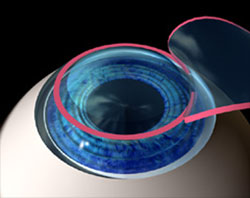
Treating nearsightedness,
the cornea is made flatter
To treat farsightedness, the flat cornea is made steeper by removing tissue outside of the central optical zone of the cornea. This moves the point of focus from behind the retina to directly on the retina.

Treating farsightedness,
the cornea is made steeper
To treat astigmatism, the cornea is made more spherical — like a basketball instead of a football. This eliminates multiple focusing points within the eye and creates one point of focus on the retina. Astigmatism can be treated at the same time as nearsightedness and farsightedness.
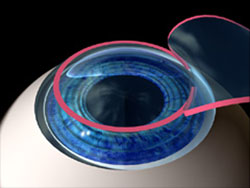
Treating astigmatism,
the cornea is made more spherical
LASIK is for those who:
- want to reduce or eliminate thir dependence on glasses or contacts
- are at least 18 years of age
- have had a stable eye prescription for at least one year
- have no health issues affecting their eyes
- have no signs of glaucoma or cataracts
What to expect on surgery day:

You will arrive at the laser center about an hour prior to your procedure
You will arrive at the laser center about an hour prior to your procedure. Once you have been checked in you may be offered a sedative to help you relax. You will then be prepared for surgery. The area around your eyes will be cleaned and a sterile drape may be applied around your eye. Anesthetic eye drops will be used to numb your eyes; no injections or needles will be used. When your eye is completely numb, an eyelid holder will be placed between your eyelids to keep you from blinking during the procedure.
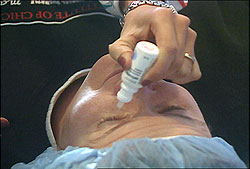
The area around your eyes will be cleaned
and a sterile drape may be applied around your eye
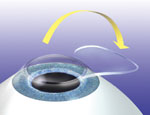 Next, an instrument called a microkeratome will create a hinged flap of thin corneal tissue, and your doctor will gently fold the flap out of the way. During this process, you may feel a little pressure, but no pain. You will then be asked to look directly at a target light while the laser reshapes your cornea. The Excimer laser will be programmed with the information gathered in your pre-operative exam. The laser treatment will be completed in less than a minute or two, depending on the amount of correction needed. To finish the procedure, the protective layer will be folded back into place where it will bond without the need for stitches.
Next, an instrument called a microkeratome will create a hinged flap of thin corneal tissue, and your doctor will gently fold the flap out of the way. During this process, you may feel a little pressure, but no pain. You will then be asked to look directly at a target light while the laser reshapes your cornea. The Excimer laser will be programmed with the information gathered in your pre-operative exam. The laser treatment will be completed in less than a minute or two, depending on the amount of correction needed. To finish the procedure, the protective layer will be folded back into place where it will bond without the need for stitches.
 Following your procedure, your eye(s) will be examined with a slit lamp microscope. Then you will be given additional eye drops, and your eyes may be shielded for protection. Your vision will probably be a little blurry at first, so someone will need to drive you home. You should relax for the rest of the day. You may experience some discomfort for 12 to 24 hours, but this is usually alleviated with an over-the-counter pain reliever. Some people experience sensitivity to light, and watering or swelling of their eyes for a few days following their procedure.
Following your procedure, your eye(s) will be examined with a slit lamp microscope. Then you will be given additional eye drops, and your eyes may be shielded for protection. Your vision will probably be a little blurry at first, so someone will need to drive you home. You should relax for the rest of the day. You may experience some discomfort for 12 to 24 hours, but this is usually alleviated with an over-the-counter pain reliever. Some people experience sensitivity to light, and watering or swelling of their eyes for a few days following their procedure.
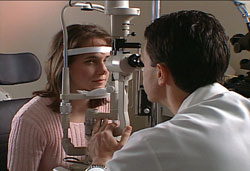
Following your procedure, your eye(s) will be examined with a slit lamp microscope
 You will be asked to come back the next day for another examination of your eye(s). Most people can actually see well enough to drive the next day but it’s best not to drive until you have been examined. You should be able to resume your normal activities the day after surgery.
You will be asked to come back the next day for another examination of your eye(s). Most people can actually see well enough to drive the next day but it’s best not to drive until you have been examined. You should be able to resume your normal activities the day after surgery.
 Vision can fluctuate for up to six months, but most people can see well enough to pass a driver’s license vision exam following their procedure.
Vision can fluctuate for up to six months, but most people can see well enough to pass a driver’s license vision exam following their procedure.
Realistic expectations:

The vast majority of our patients can do most activities without dependence on corrective lenses.
The decision to have LASIK is an important one that only you can make. The goal of any refractive surgical procedure is to reduce your dependence on corrective lenses. However, we cannot guarantee you will have the results you desire. The vast majority of our patients are extremely happy with their vision after LASIK and can do most activities without dependence on corrective lenses.
Serious complications with LASIK are extremely rare. LASIK is a safe, effective and permanent procedure, but like any surgical procedure, it does have some risks. Many of the risks and complications associated with this procedure can be reduced or eliminated through careful patient selection and thorough pre-operative testing using the latest diagnostic technology.
After LASIK, you may experience some visual side effects. These visual side effects are usually mild and diminish over time. But there is a slight chance that some of these side effects won’t go away completely, such as feelings of dryness, glare and halos.

Everyone heals somewhat differently
Since everyone heals somewhat differently, some patients may over react to the procedure and some may under react resulting in overcorrections and undercorrections. Once the eye has stablized (3 to 6 months) you and your doctor can discuss whether a re-treatment could help fine tune your vision if you are over or under corrected.
After a thorough eye exam, you and your doctor will determine if LASIK is an option for you. If you are a good candidate, you will be given additional information about the procedure that will allow you to make an informed decision about whether to proceed. Be sure you have all your questions answered to your satisfaction.
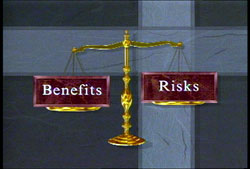
Be sure you have all your questions answered to your satisfaction
Alternatives to LASIK
LASIK is not the only surgical procedure designed to correct nearsightedness, farsightedness and astigmatism. To learn about other procedures go to the surgical and laser vision correction procedures section of our Web Site. If you would like to learn more about vision correction procedures from sources other than our practice, we encourage you to link to a number of Web sites we feel provide factual and up-to-date information. You may also choose to make an appointment or request additional information to learn more about this exciting procedure.


